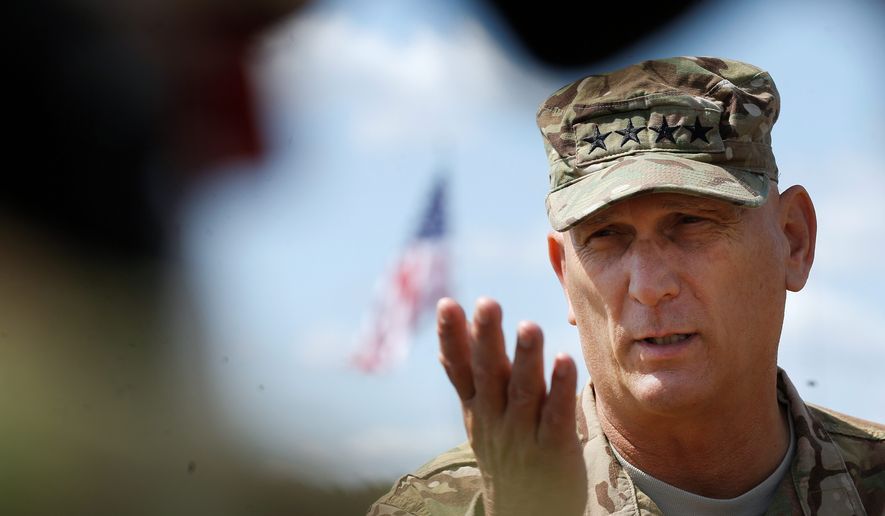Female soldiers suffered double the rate of injuries compared with male colleagues in Army combat training, including jobs in field artillery and repairing the Bradley fighting vehicle.
The startling statistics come from Army studies obtained by the Center for Military Readiness, a research group that opposes what the Obama administration is expected to do by year’s end: putting women in the direct land combat in infantry, armor, artillery and special operations units.
Retired Gen. Raymond Odierno, who completed his four-year stint as Army chief of staff, said earlier this month that he already has decided to open all artillery jobs to women, except one that embeds with infantry units. The final decision on coed infantry and tank units will be made soon, he told the Army Times.
“We’ve done a lot of pilot programs, we’ve done a lot of physical testing, we’ve done a lot of testing on how we integrate women into units, and those are all going well,” Gen. Odierno said. “We want the best person, if they’re qualified and meet the standards, we want to give them the opportunity to do whatever they want.”
A CMR report paints a less upbeat picture.
The research group filed several Freedom of Information Act requests to obtain documents from the Army on injury rates for women enrolled in combat job experiments since 2012. The Army turned over mounds of reports from its Medical Command and the Army Institute of Public Health.
SEE ALSO: First women soldiers complete Army Ranger school
Data showed that women in the military occupational specialty (MOS) of artillery surveyor meteorological crew member suffered more than double (113 percent) the injuries of men.
Women in basic combat, combat vehicle maintenance and engineers training produced the same lopsided injury ratio.
“Department of Defense and Congress need to seriously consider the consequences of physical inequality between men and women,” said Elaine Donnelly, who runs CMR. “It is easy to take our military for granted. It is the best in the world. It will not stay that way, however, if officials combine severe budget cuts with misguided social experiments.”
She added: “Military women have a right to know about risks related to differences in physiology, which are not going to change.”
The documents did not list the types of injuries but did include bar graphs that revealed the toll on women’s bodies, Mrs. Donnelly said. She said she also requested surveys on soldier attitudes toward women in direct ground combat. She said the Army provided them, but only with the title and general topics. The results were redacted.
Mrs. Donnelly said the injury rates will translate into readiness problems down the road.
SEE ALSO: DoD manual allows journalists to be held as ‘belligerents’
“Double risks of injury among women, combined with expected absences due to pregnancy and other gender-related issues, would be even more problematic in small combat units with four to 12 members, such as M1 tank crews, infantry rifle squads, or cannon artillery gun crews,” she said. “The absence of female team members would compromise missions and put everyone’s lives at greater risk.”
Then-Defense Secretary Leon E. Panetta announced in January 2013 that he had rescinded the Pentagon’s ban on women in direct land combat units. The services were ordered to study each previously closed occupation. If they want to keep an MOS all-male, they must request a waiver from Defense Secretary Ashton Carter.
The four services and U.S. Special Operations Command are due to present their recommendations to the Pentagon next month. Then Mr. Carter’s staff will then evaluate them, and he will make a final decision by Dec. 31.
Momentum is building to introduce women into virtually all MOSes.
• Mr. Carter already has stated publicly that most or all will be opened to women.
• Two female officers completed the Army Ranger course, an indication that women can pass general infantry training, though in what numbers is unclear. Mr. Odierno said a new Ranger School class will again include women in November.
• Female enlisted Marines have been able to complete basic infantry training. But none could pass the more demanding Infantry Officer Course.
• The Navy plans to open tryouts for naval special warfare, including SEAL teams, to women. It has not conducted any trial runs with women. Army Special Forces and the Ranger 175th Regiment also have not conducted experiments with women tryouts. It would be difficult for the Army to ask Mr. Carter to keep the special operations ban, while the Navy is letting women compete for the SEALs.
“The women in Ranger School are another example of, if they can meet the standard, they should be able to go, and they should be able to earn their Ranger tab,” Gen. Odierno told reporters during his final Pentagon press conference. “And I think that’s how we want to operate as we move forward.”
Completing Ranger School is a career enhancer but does not make graduates part of the Ranger regiment, which requires its own grueling path to graduation.
“We’ve not made any final decisions on infantry or armor yet, but I think those are coming very shortly,” Gen. Odierno said. “We have really collected some significant analysis. We’ve done really incredible studies over the last two years. We’ve integrated women into all our formations, and again, it is about can they meet the standard or not, and if they can, we lean towards the fact it would probably be good if we allowed them to serve.”
• Rowan Scarborough can be reached at rscarborough@washingtontimes.com.




Please read our comment policy before commenting.